MGMT601: Developing a Personal Leadership Strategy Report
VerifiedAdded on 2022/10/06
|19
|5218
|206
Report
AI Summary
This report presents a comprehensive exploration of dynamic leadership, focusing on self-awareness and leadership development strategies. It begins with an introduction emphasizing the importance of self-awareness as the foundation of leadership, followed by a theoretical analysis using Intentional Change Theory to guide personal development. The report details the steps involved in developing a leadership plan, including practical application of desired changes, maintaining relationships, and motivating others. It then delves into coaching practices aimed at enhancing self-awareness and core communication skills, including stages of emotional intelligence development, active listening, and feedback exchange. The importance of reflective and reflexive practice in self-development is discussed, utilizing Schon’s Critical lens and Gibbs Learning Cycle. The report concludes by summarizing the key takeaways and providing a reference list and appendix, including an individual development plan. The assignment fulfills the requirements of MGT601: Dynamic Leadership, focusing on personal leadership development and practical application of leadership theories.
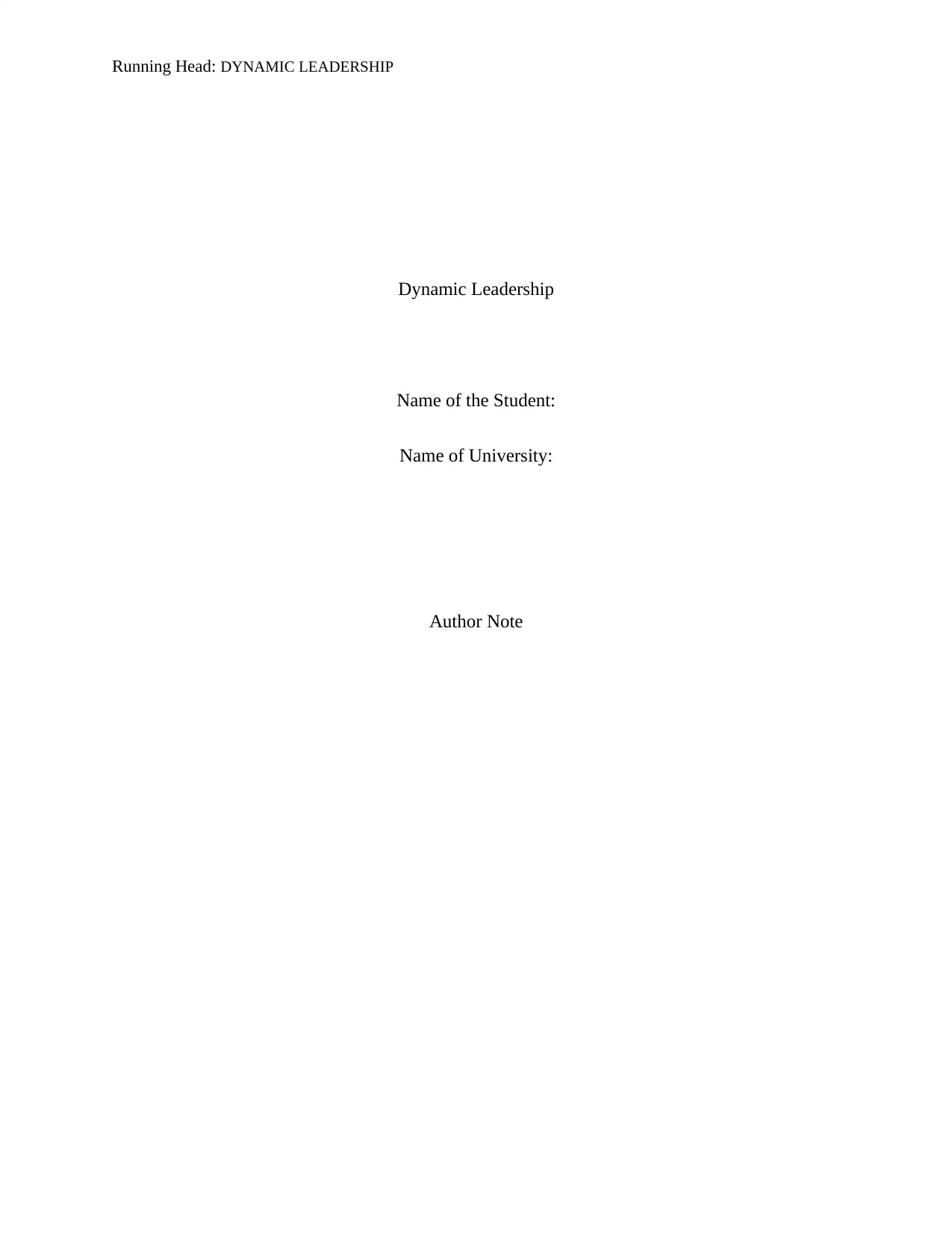
Running Head: DYNAMIC LEADERSHIP
Dynamic Leadership
Name of the Student:
Name of University:
Author Note
Dynamic Leadership
Name of the Student:
Name of University:
Author Note
Paraphrase This Document
Need a fresh take? Get an instant paraphrase of this document with our AI Paraphraser
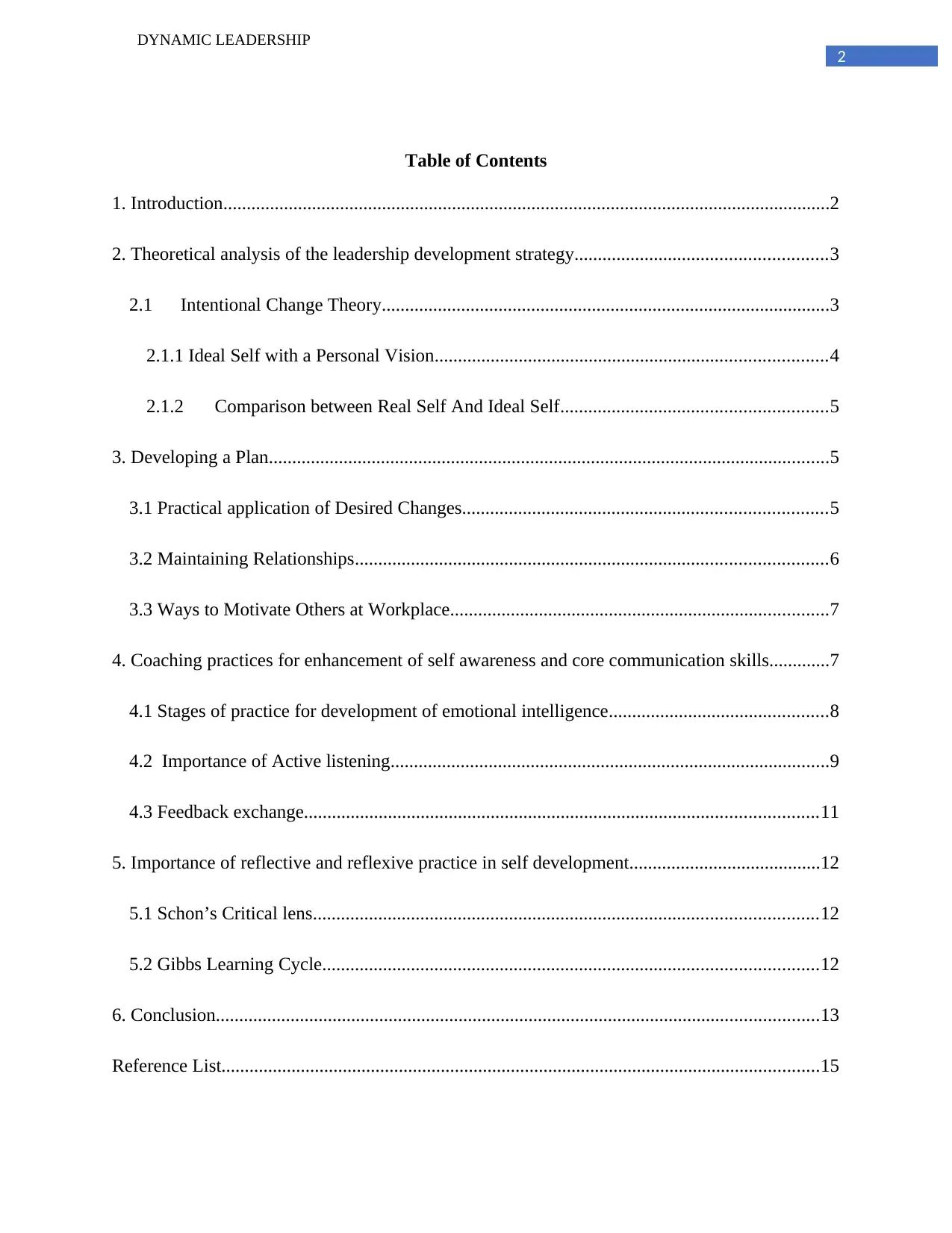
2
DYNAMIC LEADERSHIP
Table of Contents
1. Introduction..................................................................................................................................2
2. Theoretical analysis of the leadership development strategy......................................................3
2.1 Intentional Change Theory................................................................................................3
2.1.1 Ideal Self with a Personal Vision....................................................................................4
2.1.2 Comparison between Real Self And Ideal Self.........................................................5
3. Developing a Plan........................................................................................................................5
3.1 Practical application of Desired Changes..............................................................................5
3.2 Maintaining Relationships.....................................................................................................6
3.3 Ways to Motivate Others at Workplace.................................................................................7
4. Coaching practices for enhancement of self awareness and core communication skills.............7
4.1 Stages of practice for development of emotional intelligence...............................................8
4.2 Importance of Active listening..............................................................................................9
4.3 Feedback exchange..............................................................................................................11
5. Importance of reflective and reflexive practice in self development.........................................12
5.1 Schon’s Critical lens............................................................................................................12
5.2 Gibbs Learning Cycle..........................................................................................................12
6. Conclusion.................................................................................................................................13
Reference List................................................................................................................................15
DYNAMIC LEADERSHIP
Table of Contents
1. Introduction..................................................................................................................................2
2. Theoretical analysis of the leadership development strategy......................................................3
2.1 Intentional Change Theory................................................................................................3
2.1.1 Ideal Self with a Personal Vision....................................................................................4
2.1.2 Comparison between Real Self And Ideal Self.........................................................5
3. Developing a Plan........................................................................................................................5
3.1 Practical application of Desired Changes..............................................................................5
3.2 Maintaining Relationships.....................................................................................................6
3.3 Ways to Motivate Others at Workplace.................................................................................7
4. Coaching practices for enhancement of self awareness and core communication skills.............7
4.1 Stages of practice for development of emotional intelligence...............................................8
4.2 Importance of Active listening..............................................................................................9
4.3 Feedback exchange..............................................................................................................11
5. Importance of reflective and reflexive practice in self development.........................................12
5.1 Schon’s Critical lens............................................................................................................12
5.2 Gibbs Learning Cycle..........................................................................................................12
6. Conclusion.................................................................................................................................13
Reference List................................................................................................................................15
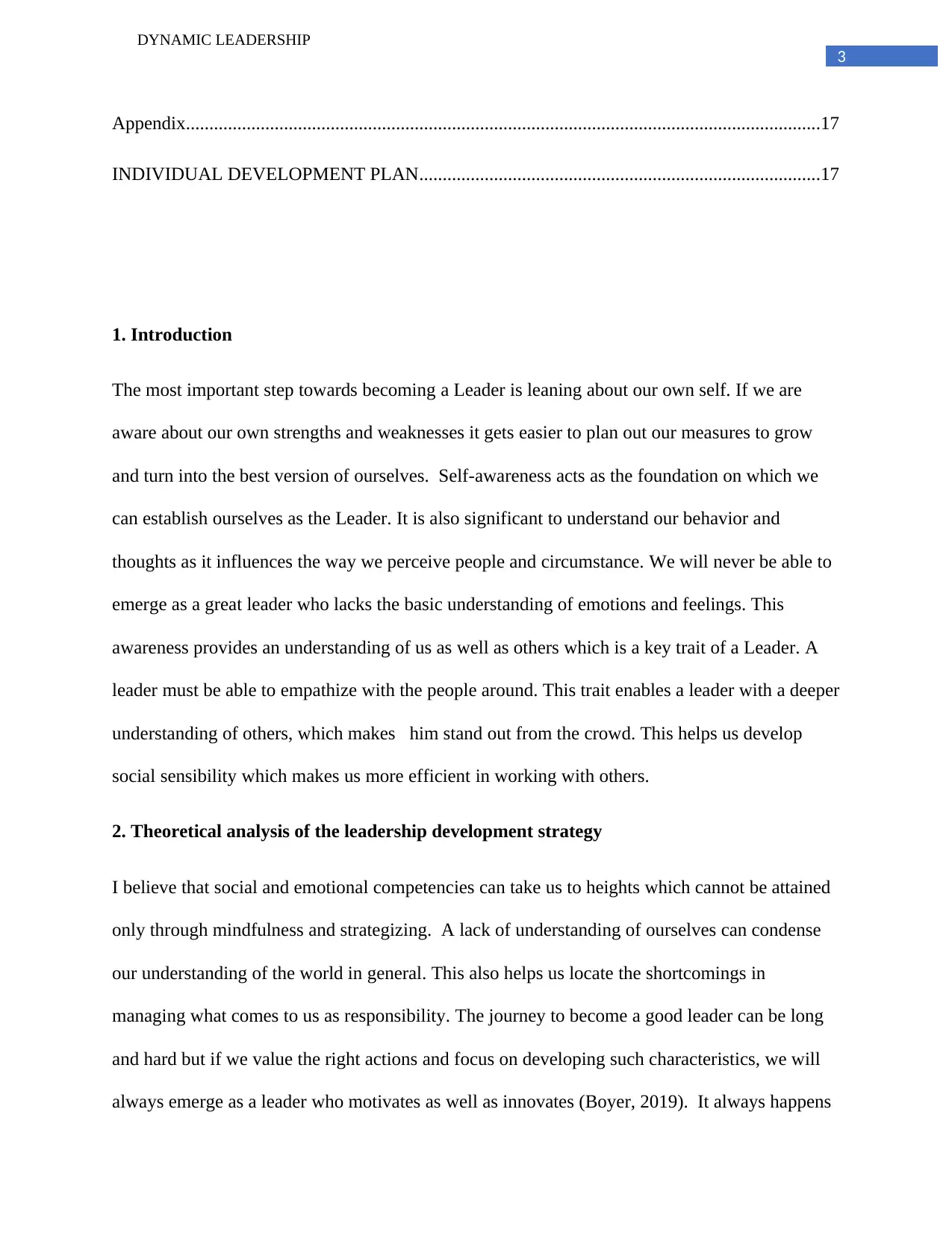
3
DYNAMIC LEADERSHIP
Appendix........................................................................................................................................17
INDIVIDUAL DEVELOPMENT PLAN......................................................................................17
1. Introduction
The most important step towards becoming a Leader is leaning about our own self. If we are
aware about our own strengths and weaknesses it gets easier to plan out our measures to grow
and turn into the best version of ourselves. Self-awareness acts as the foundation on which we
can establish ourselves as the Leader. It is also significant to understand our behavior and
thoughts as it influences the way we perceive people and circumstance. We will never be able to
emerge as a great leader who lacks the basic understanding of emotions and feelings. This
awareness provides an understanding of us as well as others which is a key trait of a Leader. A
leader must be able to empathize with the people around. This trait enables a leader with a deeper
understanding of others, which makes him stand out from the crowd. This helps us develop
social sensibility which makes us more efficient in working with others.
2. Theoretical analysis of the leadership development strategy
I believe that social and emotional competencies can take us to heights which cannot be attained
only through mindfulness and strategizing. A lack of understanding of ourselves can condense
our understanding of the world in general. This also helps us locate the shortcomings in
managing what comes to us as responsibility. The journey to become a good leader can be long
and hard but if we value the right actions and focus on developing such characteristics, we will
always emerge as a leader who motivates as well as innovates (Boyer, 2019). It always happens
DYNAMIC LEADERSHIP
Appendix........................................................................................................................................17
INDIVIDUAL DEVELOPMENT PLAN......................................................................................17
1. Introduction
The most important step towards becoming a Leader is leaning about our own self. If we are
aware about our own strengths and weaknesses it gets easier to plan out our measures to grow
and turn into the best version of ourselves. Self-awareness acts as the foundation on which we
can establish ourselves as the Leader. It is also significant to understand our behavior and
thoughts as it influences the way we perceive people and circumstance. We will never be able to
emerge as a great leader who lacks the basic understanding of emotions and feelings. This
awareness provides an understanding of us as well as others which is a key trait of a Leader. A
leader must be able to empathize with the people around. This trait enables a leader with a deeper
understanding of others, which makes him stand out from the crowd. This helps us develop
social sensibility which makes us more efficient in working with others.
2. Theoretical analysis of the leadership development strategy
I believe that social and emotional competencies can take us to heights which cannot be attained
only through mindfulness and strategizing. A lack of understanding of ourselves can condense
our understanding of the world in general. This also helps us locate the shortcomings in
managing what comes to us as responsibility. The journey to become a good leader can be long
and hard but if we value the right actions and focus on developing such characteristics, we will
always emerge as a leader who motivates as well as innovates (Boyer, 2019). It always happens
⊘ This is a preview!⊘
Do you want full access?
Subscribe today to unlock all pages.

Trusted by 1+ million students worldwide
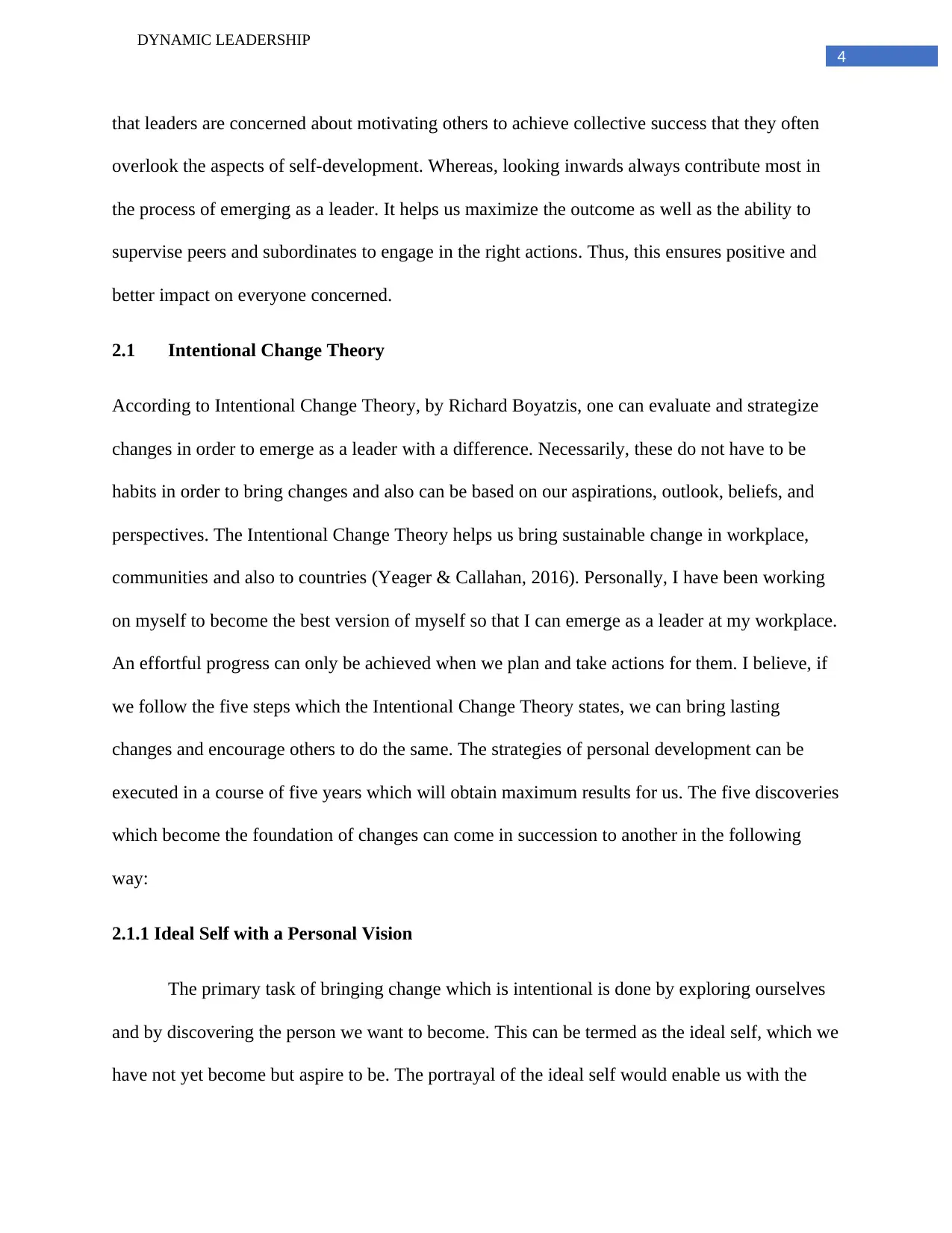
4
DYNAMIC LEADERSHIP
that leaders are concerned about motivating others to achieve collective success that they often
overlook the aspects of self-development. Whereas, looking inwards always contribute most in
the process of emerging as a leader. It helps us maximize the outcome as well as the ability to
supervise peers and subordinates to engage in the right actions. Thus, this ensures positive and
better impact on everyone concerned.
2.1 Intentional Change Theory
According to Intentional Change Theory, by Richard Boyatzis, one can evaluate and strategize
changes in order to emerge as a leader with a difference. Necessarily, these do not have to be
habits in order to bring changes and also can be based on our aspirations, outlook, beliefs, and
perspectives. The Intentional Change Theory helps us bring sustainable change in workplace,
communities and also to countries (Yeager & Callahan, 2016). Personally, I have been working
on myself to become the best version of myself so that I can emerge as a leader at my workplace.
An effortful progress can only be achieved when we plan and take actions for them. I believe, if
we follow the five steps which the Intentional Change Theory states, we can bring lasting
changes and encourage others to do the same. The strategies of personal development can be
executed in a course of five years which will obtain maximum results for us. The five discoveries
which become the foundation of changes can come in succession to another in the following
way:
2.1.1 Ideal Self with a Personal Vision
The primary task of bringing change which is intentional is done by exploring ourselves
and by discovering the person we want to become. This can be termed as the ideal self, which we
have not yet become but aspire to be. The portrayal of the ideal self would enable us with the
DYNAMIC LEADERSHIP
that leaders are concerned about motivating others to achieve collective success that they often
overlook the aspects of self-development. Whereas, looking inwards always contribute most in
the process of emerging as a leader. It helps us maximize the outcome as well as the ability to
supervise peers and subordinates to engage in the right actions. Thus, this ensures positive and
better impact on everyone concerned.
2.1 Intentional Change Theory
According to Intentional Change Theory, by Richard Boyatzis, one can evaluate and strategize
changes in order to emerge as a leader with a difference. Necessarily, these do not have to be
habits in order to bring changes and also can be based on our aspirations, outlook, beliefs, and
perspectives. The Intentional Change Theory helps us bring sustainable change in workplace,
communities and also to countries (Yeager & Callahan, 2016). Personally, I have been working
on myself to become the best version of myself so that I can emerge as a leader at my workplace.
An effortful progress can only be achieved when we plan and take actions for them. I believe, if
we follow the five steps which the Intentional Change Theory states, we can bring lasting
changes and encourage others to do the same. The strategies of personal development can be
executed in a course of five years which will obtain maximum results for us. The five discoveries
which become the foundation of changes can come in succession to another in the following
way:
2.1.1 Ideal Self with a Personal Vision
The primary task of bringing change which is intentional is done by exploring ourselves
and by discovering the person we want to become. This can be termed as the ideal self, which we
have not yet become but aspire to be. The portrayal of the ideal self would enable us with the
Paraphrase This Document
Need a fresh take? Get an instant paraphrase of this document with our AI Paraphraser
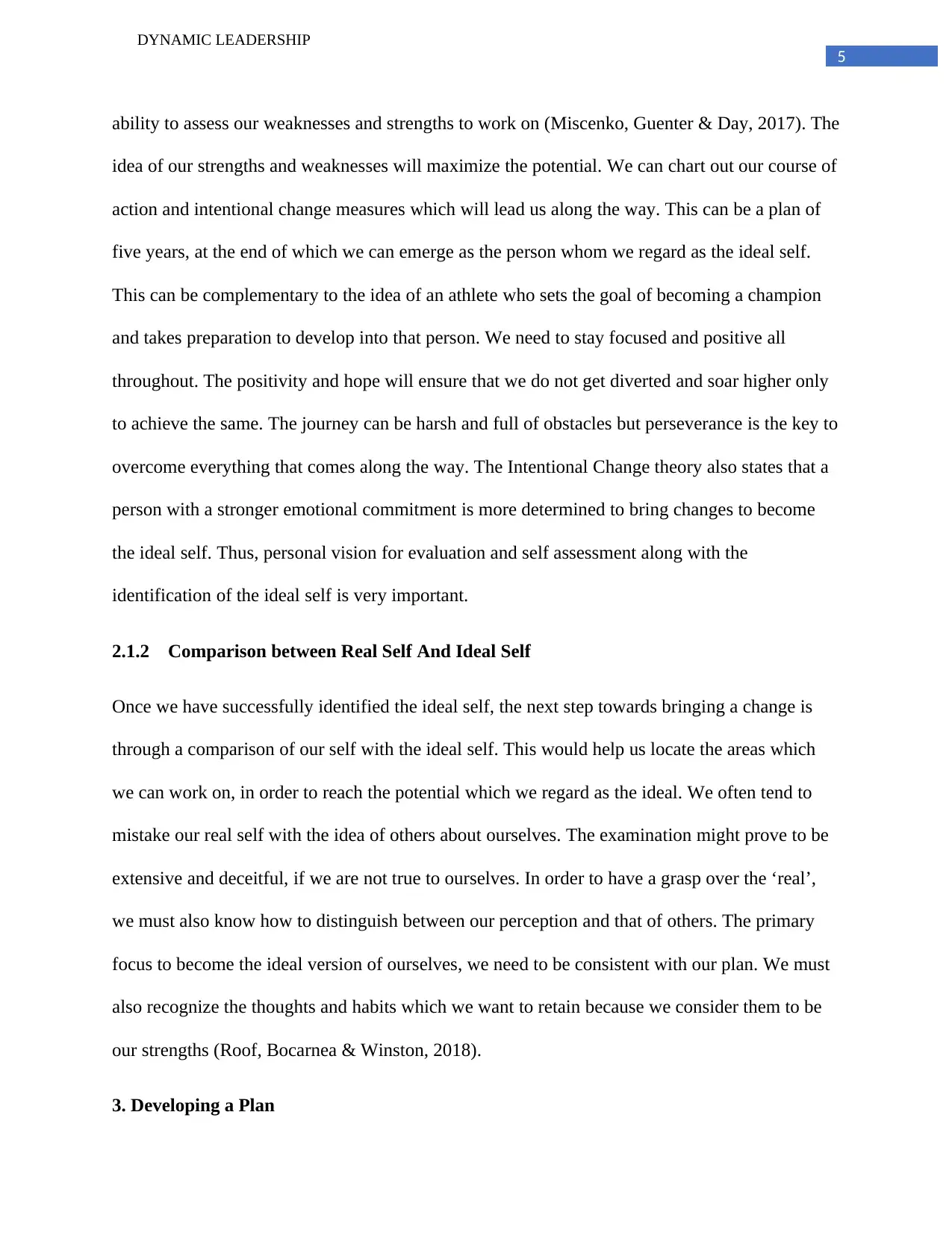
5
DYNAMIC LEADERSHIP
ability to assess our weaknesses and strengths to work on (Miscenko, Guenter & Day, 2017). The
idea of our strengths and weaknesses will maximize the potential. We can chart out our course of
action and intentional change measures which will lead us along the way. This can be a plan of
five years, at the end of which we can emerge as the person whom we regard as the ideal self.
This can be complementary to the idea of an athlete who sets the goal of becoming a champion
and takes preparation to develop into that person. We need to stay focused and positive all
throughout. The positivity and hope will ensure that we do not get diverted and soar higher only
to achieve the same. The journey can be harsh and full of obstacles but perseverance is the key to
overcome everything that comes along the way. The Intentional Change theory also states that a
person with a stronger emotional commitment is more determined to bring changes to become
the ideal self. Thus, personal vision for evaluation and self assessment along with the
identification of the ideal self is very important.
2.1.2 Comparison between Real Self And Ideal Self
Once we have successfully identified the ideal self, the next step towards bringing a change is
through a comparison of our self with the ideal self. This would help us locate the areas which
we can work on, in order to reach the potential which we regard as the ideal. We often tend to
mistake our real self with the idea of others about ourselves. The examination might prove to be
extensive and deceitful, if we are not true to ourselves. In order to have a grasp over the ‘real’,
we must also know how to distinguish between our perception and that of others. The primary
focus to become the ideal version of ourselves, we need to be consistent with our plan. We must
also recognize the thoughts and habits which we want to retain because we consider them to be
our strengths (Roof, Bocarnea & Winston, 2018).
3. Developing a Plan
DYNAMIC LEADERSHIP
ability to assess our weaknesses and strengths to work on (Miscenko, Guenter & Day, 2017). The
idea of our strengths and weaknesses will maximize the potential. We can chart out our course of
action and intentional change measures which will lead us along the way. This can be a plan of
five years, at the end of which we can emerge as the person whom we regard as the ideal self.
This can be complementary to the idea of an athlete who sets the goal of becoming a champion
and takes preparation to develop into that person. We need to stay focused and positive all
throughout. The positivity and hope will ensure that we do not get diverted and soar higher only
to achieve the same. The journey can be harsh and full of obstacles but perseverance is the key to
overcome everything that comes along the way. The Intentional Change theory also states that a
person with a stronger emotional commitment is more determined to bring changes to become
the ideal self. Thus, personal vision for evaluation and self assessment along with the
identification of the ideal self is very important.
2.1.2 Comparison between Real Self And Ideal Self
Once we have successfully identified the ideal self, the next step towards bringing a change is
through a comparison of our self with the ideal self. This would help us locate the areas which
we can work on, in order to reach the potential which we regard as the ideal. We often tend to
mistake our real self with the idea of others about ourselves. The examination might prove to be
extensive and deceitful, if we are not true to ourselves. In order to have a grasp over the ‘real’,
we must also know how to distinguish between our perception and that of others. The primary
focus to become the ideal version of ourselves, we need to be consistent with our plan. We must
also recognize the thoughts and habits which we want to retain because we consider them to be
our strengths (Roof, Bocarnea & Winston, 2018).
3. Developing a Plan
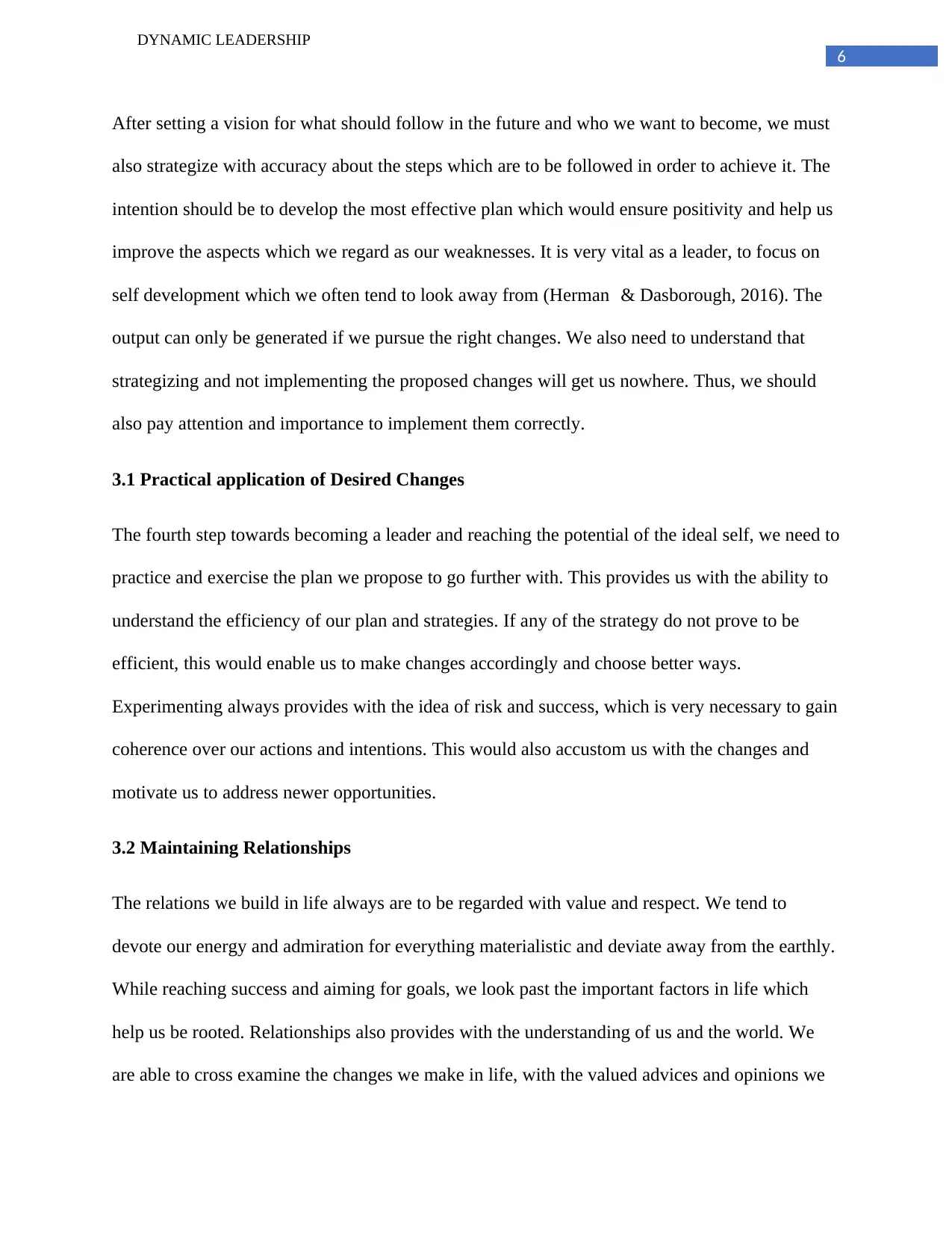
6
DYNAMIC LEADERSHIP
After setting a vision for what should follow in the future and who we want to become, we must
also strategize with accuracy about the steps which are to be followed in order to achieve it. The
intention should be to develop the most effective plan which would ensure positivity and help us
improve the aspects which we regard as our weaknesses. It is very vital as a leader, to focus on
self development which we often tend to look away from (Herman & Dasborough, 2016). The
output can only be generated if we pursue the right changes. We also need to understand that
strategizing and not implementing the proposed changes will get us nowhere. Thus, we should
also pay attention and importance to implement them correctly.
3.1 Practical application of Desired Changes
The fourth step towards becoming a leader and reaching the potential of the ideal self, we need to
practice and exercise the plan we propose to go further with. This provides us with the ability to
understand the efficiency of our plan and strategies. If any of the strategy do not prove to be
efficient, this would enable us to make changes accordingly and choose better ways.
Experimenting always provides with the idea of risk and success, which is very necessary to gain
coherence over our actions and intentions. This would also accustom us with the changes and
motivate us to address newer opportunities.
3.2 Maintaining Relationships
The relations we build in life always are to be regarded with value and respect. We tend to
devote our energy and admiration for everything materialistic and deviate away from the earthly.
While reaching success and aiming for goals, we look past the important factors in life which
help us be rooted. Relationships also provides with the understanding of us and the world. We
are able to cross examine the changes we make in life, with the valued advices and opinions we
DYNAMIC LEADERSHIP
After setting a vision for what should follow in the future and who we want to become, we must
also strategize with accuracy about the steps which are to be followed in order to achieve it. The
intention should be to develop the most effective plan which would ensure positivity and help us
improve the aspects which we regard as our weaknesses. It is very vital as a leader, to focus on
self development which we often tend to look away from (Herman & Dasborough, 2016). The
output can only be generated if we pursue the right changes. We also need to understand that
strategizing and not implementing the proposed changes will get us nowhere. Thus, we should
also pay attention and importance to implement them correctly.
3.1 Practical application of Desired Changes
The fourth step towards becoming a leader and reaching the potential of the ideal self, we need to
practice and exercise the plan we propose to go further with. This provides us with the ability to
understand the efficiency of our plan and strategies. If any of the strategy do not prove to be
efficient, this would enable us to make changes accordingly and choose better ways.
Experimenting always provides with the idea of risk and success, which is very necessary to gain
coherence over our actions and intentions. This would also accustom us with the changes and
motivate us to address newer opportunities.
3.2 Maintaining Relationships
The relations we build in life always are to be regarded with value and respect. We tend to
devote our energy and admiration for everything materialistic and deviate away from the earthly.
While reaching success and aiming for goals, we look past the important factors in life which
help us be rooted. Relationships also provides with the understanding of us and the world. We
are able to cross examine the changes we make in life, with the valued advices and opinions we
⊘ This is a preview!⊘
Do you want full access?
Subscribe today to unlock all pages.

Trusted by 1+ million students worldwide
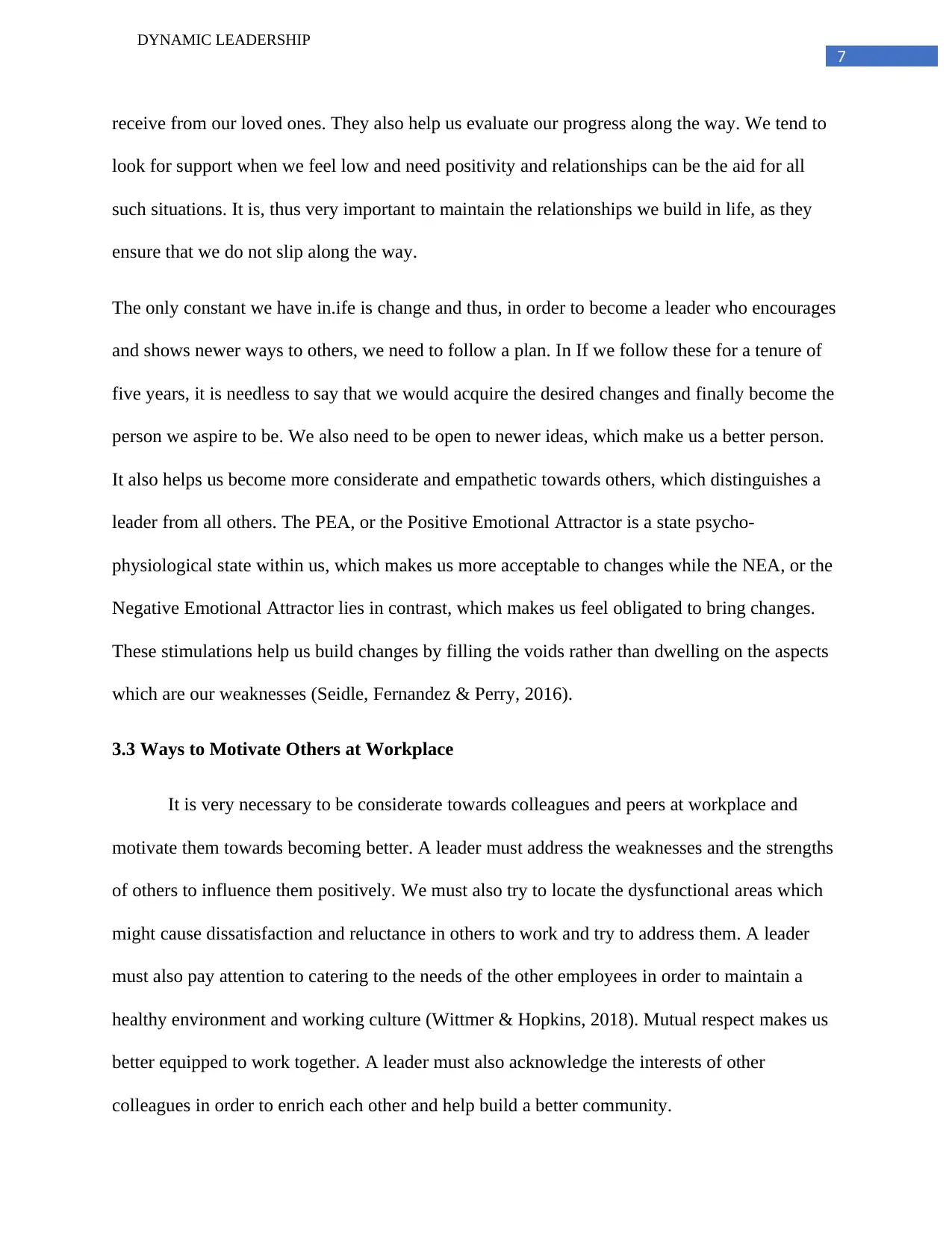
7
DYNAMIC LEADERSHIP
receive from our loved ones. They also help us evaluate our progress along the way. We tend to
look for support when we feel low and need positivity and relationships can be the aid for all
such situations. It is, thus very important to maintain the relationships we build in life, as they
ensure that we do not slip along the way.
The only constant we have in.ife is change and thus, in order to become a leader who encourages
and shows newer ways to others, we need to follow a plan. In If we follow these for a tenure of
five years, it is needless to say that we would acquire the desired changes and finally become the
person we aspire to be. We also need to be open to newer ideas, which make us a better person.
It also helps us become more considerate and empathetic towards others, which distinguishes a
leader from all others. The PEA, or the Positive Emotional Attractor is a state psycho-
physiological state within us, which makes us more acceptable to changes while the NEA, or the
Negative Emotional Attractor lies in contrast, which makes us feel obligated to bring changes.
These stimulations help us build changes by filling the voids rather than dwelling on the aspects
which are our weaknesses (Seidle, Fernandez & Perry, 2016).
3.3 Ways to Motivate Others at Workplace
It is very necessary to be considerate towards colleagues and peers at workplace and
motivate them towards becoming better. A leader must address the weaknesses and the strengths
of others to influence them positively. We must also try to locate the dysfunctional areas which
might cause dissatisfaction and reluctance in others to work and try to address them. A leader
must also pay attention to catering to the needs of the other employees in order to maintain a
healthy environment and working culture (Wittmer & Hopkins, 2018). Mutual respect makes us
better equipped to work together. A leader must also acknowledge the interests of other
colleagues in order to enrich each other and help build a better community.
DYNAMIC LEADERSHIP
receive from our loved ones. They also help us evaluate our progress along the way. We tend to
look for support when we feel low and need positivity and relationships can be the aid for all
such situations. It is, thus very important to maintain the relationships we build in life, as they
ensure that we do not slip along the way.
The only constant we have in.ife is change and thus, in order to become a leader who encourages
and shows newer ways to others, we need to follow a plan. In If we follow these for a tenure of
five years, it is needless to say that we would acquire the desired changes and finally become the
person we aspire to be. We also need to be open to newer ideas, which make us a better person.
It also helps us become more considerate and empathetic towards others, which distinguishes a
leader from all others. The PEA, or the Positive Emotional Attractor is a state psycho-
physiological state within us, which makes us more acceptable to changes while the NEA, or the
Negative Emotional Attractor lies in contrast, which makes us feel obligated to bring changes.
These stimulations help us build changes by filling the voids rather than dwelling on the aspects
which are our weaknesses (Seidle, Fernandez & Perry, 2016).
3.3 Ways to Motivate Others at Workplace
It is very necessary to be considerate towards colleagues and peers at workplace and
motivate them towards becoming better. A leader must address the weaknesses and the strengths
of others to influence them positively. We must also try to locate the dysfunctional areas which
might cause dissatisfaction and reluctance in others to work and try to address them. A leader
must also pay attention to catering to the needs of the other employees in order to maintain a
healthy environment and working culture (Wittmer & Hopkins, 2018). Mutual respect makes us
better equipped to work together. A leader must also acknowledge the interests of other
colleagues in order to enrich each other and help build a better community.
Paraphrase This Document
Need a fresh take? Get an instant paraphrase of this document with our AI Paraphraser
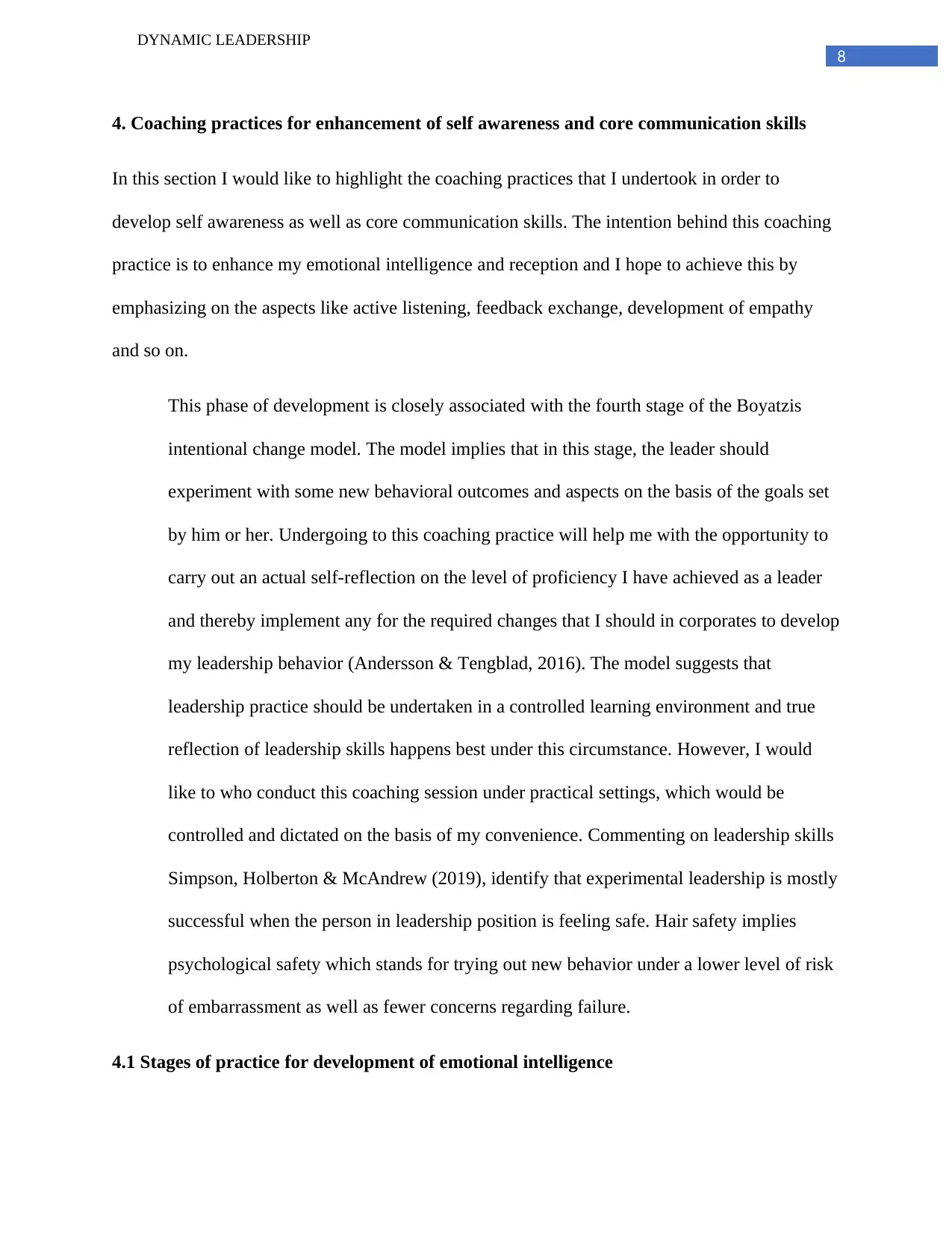
8
DYNAMIC LEADERSHIP
4. Coaching practices for enhancement of self awareness and core communication skills
In this section I would like to highlight the coaching practices that I undertook in order to
develop self awareness as well as core communication skills. The intention behind this coaching
practice is to enhance my emotional intelligence and reception and I hope to achieve this by
emphasizing on the aspects like active listening, feedback exchange, development of empathy
and so on.
This phase of development is closely associated with the fourth stage of the Boyatzis
intentional change model. The model implies that in this stage, the leader should
experiment with some new behavioral outcomes and aspects on the basis of the goals set
by him or her. Undergoing to this coaching practice will help me with the opportunity to
carry out an actual self-reflection on the level of proficiency I have achieved as a leader
and thereby implement any for the required changes that I should in corporates to develop
my leadership behavior (Andersson & Tengblad, 2016). The model suggests that
leadership practice should be undertaken in a controlled learning environment and true
reflection of leadership skills happens best under this circumstance. However, I would
like to who conduct this coaching session under practical settings, which would be
controlled and dictated on the basis of my convenience. Commenting on leadership skills
Simpson, Holberton & McAndrew (2019), identify that experimental leadership is mostly
successful when the person in leadership position is feeling safe. Hair safety implies
psychological safety which stands for trying out new behavior under a lower level of risk
of embarrassment as well as fewer concerns regarding failure.
4.1 Stages of practice for development of emotional intelligence
DYNAMIC LEADERSHIP
4. Coaching practices for enhancement of self awareness and core communication skills
In this section I would like to highlight the coaching practices that I undertook in order to
develop self awareness as well as core communication skills. The intention behind this coaching
practice is to enhance my emotional intelligence and reception and I hope to achieve this by
emphasizing on the aspects like active listening, feedback exchange, development of empathy
and so on.
This phase of development is closely associated with the fourth stage of the Boyatzis
intentional change model. The model implies that in this stage, the leader should
experiment with some new behavioral outcomes and aspects on the basis of the goals set
by him or her. Undergoing to this coaching practice will help me with the opportunity to
carry out an actual self-reflection on the level of proficiency I have achieved as a leader
and thereby implement any for the required changes that I should in corporates to develop
my leadership behavior (Andersson & Tengblad, 2016). The model suggests that
leadership practice should be undertaken in a controlled learning environment and true
reflection of leadership skills happens best under this circumstance. However, I would
like to who conduct this coaching session under practical settings, which would be
controlled and dictated on the basis of my convenience. Commenting on leadership skills
Simpson, Holberton & McAndrew (2019), identify that experimental leadership is mostly
successful when the person in leadership position is feeling safe. Hair safety implies
psychological safety which stands for trying out new behavior under a lower level of risk
of embarrassment as well as fewer concerns regarding failure.
4.1 Stages of practice for development of emotional intelligence
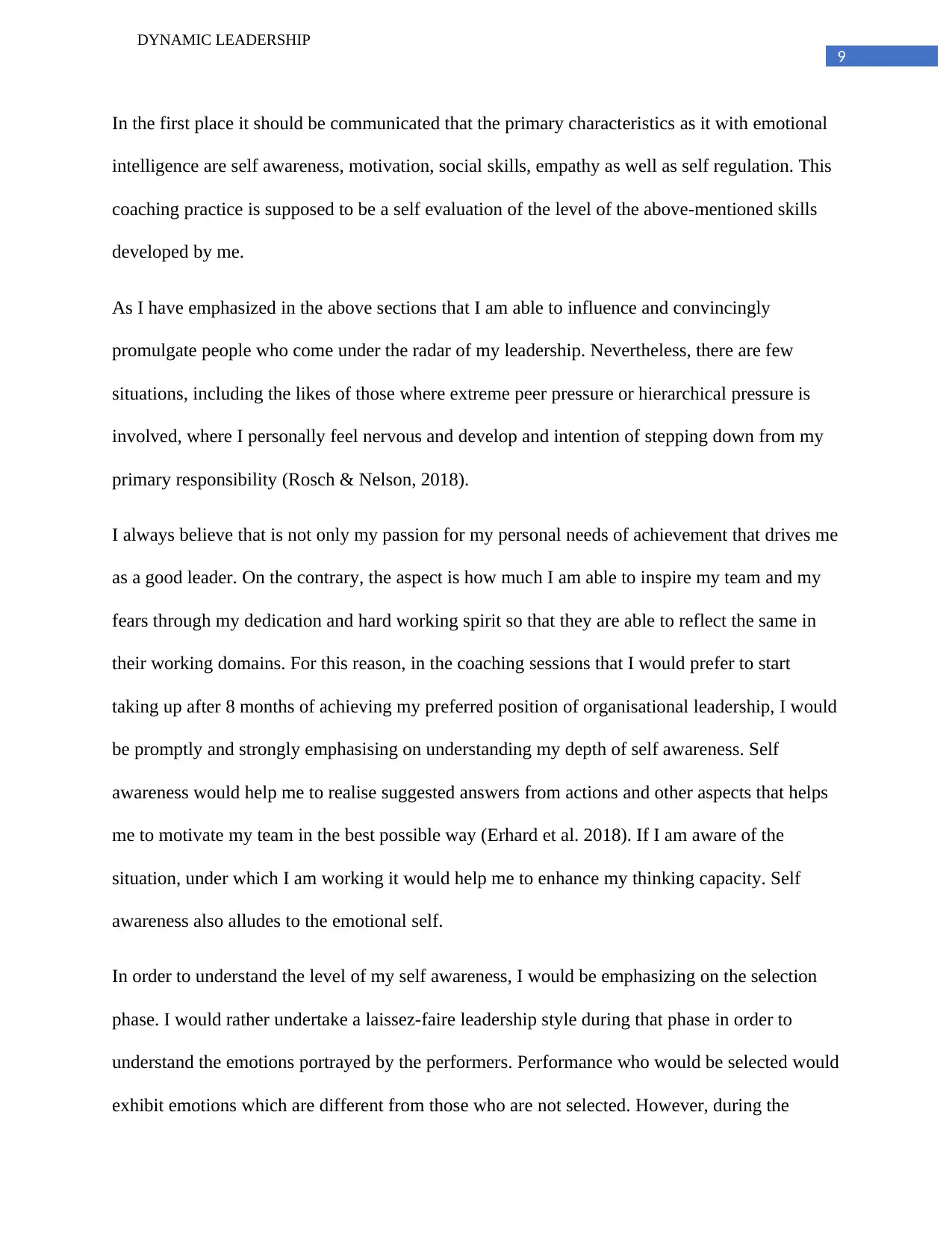
9
DYNAMIC LEADERSHIP
In the first place it should be communicated that the primary characteristics as it with emotional
intelligence are self awareness, motivation, social skills, empathy as well as self regulation. This
coaching practice is supposed to be a self evaluation of the level of the above-mentioned skills
developed by me.
As I have emphasized in the above sections that I am able to influence and convincingly
promulgate people who come under the radar of my leadership. Nevertheless, there are few
situations, including the likes of those where extreme peer pressure or hierarchical pressure is
involved, where I personally feel nervous and develop and intention of stepping down from my
primary responsibility (Rosch & Nelson, 2018).
I always believe that is not only my passion for my personal needs of achievement that drives me
as a good leader. On the contrary, the aspect is how much I am able to inspire my team and my
fears through my dedication and hard working spirit so that they are able to reflect the same in
their working domains. For this reason, in the coaching sessions that I would prefer to start
taking up after 8 months of achieving my preferred position of organisational leadership, I would
be promptly and strongly emphasising on understanding my depth of self awareness. Self
awareness would help me to realise suggested answers from actions and other aspects that helps
me to motivate my team in the best possible way (Erhard et al. 2018). If I am aware of the
situation, under which I am working it would help me to enhance my thinking capacity. Self
awareness also alludes to the emotional self.
In order to understand the level of my self awareness, I would be emphasizing on the selection
phase. I would rather undertake a laissez-faire leadership style during that phase in order to
understand the emotions portrayed by the performers. Performance who would be selected would
exhibit emotions which are different from those who are not selected. However, during the
DYNAMIC LEADERSHIP
In the first place it should be communicated that the primary characteristics as it with emotional
intelligence are self awareness, motivation, social skills, empathy as well as self regulation. This
coaching practice is supposed to be a self evaluation of the level of the above-mentioned skills
developed by me.
As I have emphasized in the above sections that I am able to influence and convincingly
promulgate people who come under the radar of my leadership. Nevertheless, there are few
situations, including the likes of those where extreme peer pressure or hierarchical pressure is
involved, where I personally feel nervous and develop and intention of stepping down from my
primary responsibility (Rosch & Nelson, 2018).
I always believe that is not only my passion for my personal needs of achievement that drives me
as a good leader. On the contrary, the aspect is how much I am able to inspire my team and my
fears through my dedication and hard working spirit so that they are able to reflect the same in
their working domains. For this reason, in the coaching sessions that I would prefer to start
taking up after 8 months of achieving my preferred position of organisational leadership, I would
be promptly and strongly emphasising on understanding my depth of self awareness. Self
awareness would help me to realise suggested answers from actions and other aspects that helps
me to motivate my team in the best possible way (Erhard et al. 2018). If I am aware of the
situation, under which I am working it would help me to enhance my thinking capacity. Self
awareness also alludes to the emotional self.
In order to understand the level of my self awareness, I would be emphasizing on the selection
phase. I would rather undertake a laissez-faire leadership style during that phase in order to
understand the emotions portrayed by the performers. Performance who would be selected would
exhibit emotions which are different from those who are not selected. However, during the
⊘ This is a preview!⊘
Do you want full access?
Subscribe today to unlock all pages.

Trusted by 1+ million students worldwide
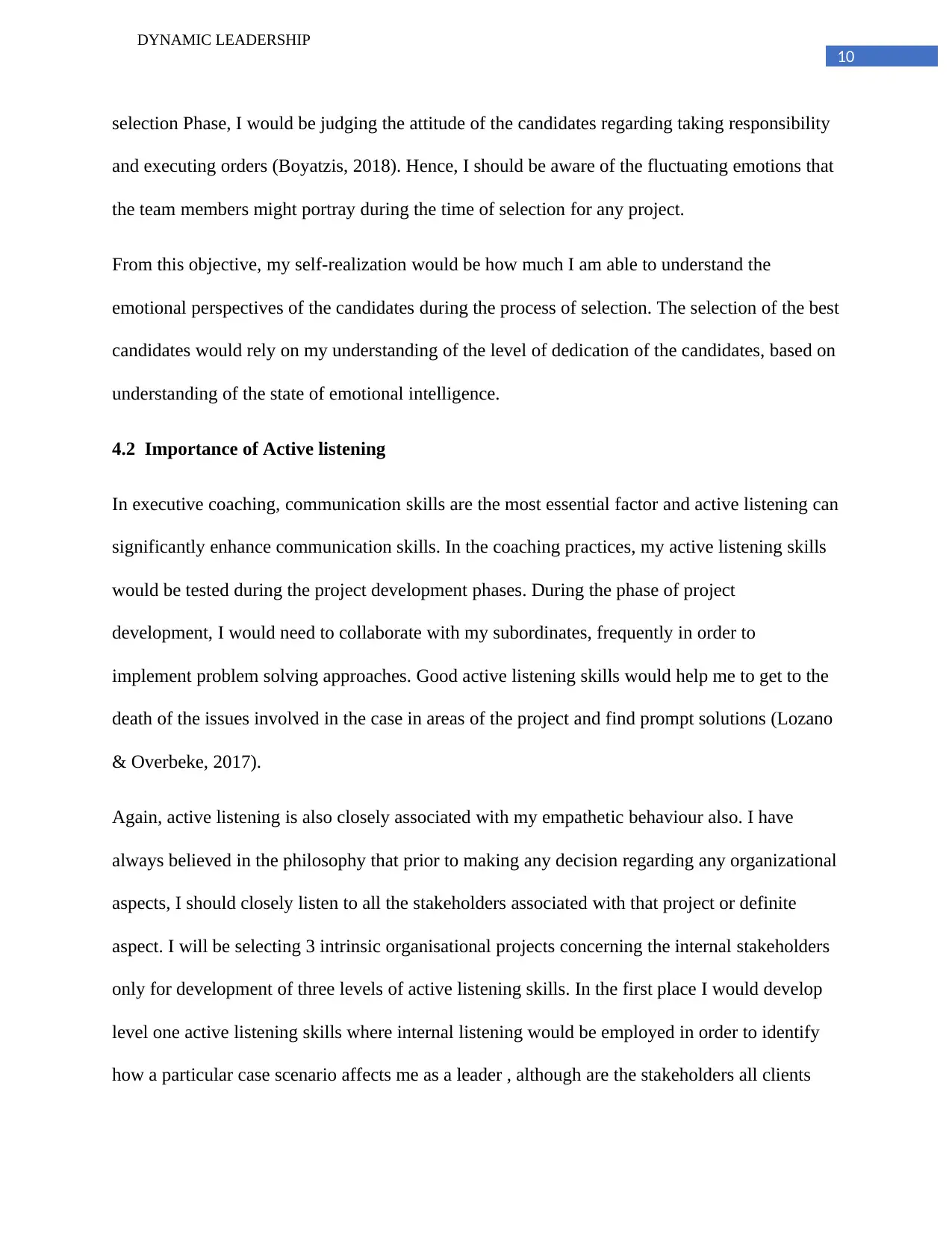
10
DYNAMIC LEADERSHIP
selection Phase, I would be judging the attitude of the candidates regarding taking responsibility
and executing orders (Boyatzis, 2018). Hence, I should be aware of the fluctuating emotions that
the team members might portray during the time of selection for any project.
From this objective, my self-realization would be how much I am able to understand the
emotional perspectives of the candidates during the process of selection. The selection of the best
candidates would rely on my understanding of the level of dedication of the candidates, based on
understanding of the state of emotional intelligence.
4.2 Importance of Active listening
In executive coaching, communication skills are the most essential factor and active listening can
significantly enhance communication skills. In the coaching practices, my active listening skills
would be tested during the project development phases. During the phase of project
development, I would need to collaborate with my subordinates, frequently in order to
implement problem solving approaches. Good active listening skills would help me to get to the
death of the issues involved in the case in areas of the project and find prompt solutions (Lozano
& Overbeke, 2017).
Again, active listening is also closely associated with my empathetic behaviour also. I have
always believed in the philosophy that prior to making any decision regarding any organizational
aspects, I should closely listen to all the stakeholders associated with that project or definite
aspect. I will be selecting 3 intrinsic organisational projects concerning the internal stakeholders
only for development of three levels of active listening skills. In the first place I would develop
level one active listening skills where internal listening would be employed in order to identify
how a particular case scenario affects me as a leader , although are the stakeholders all clients
DYNAMIC LEADERSHIP
selection Phase, I would be judging the attitude of the candidates regarding taking responsibility
and executing orders (Boyatzis, 2018). Hence, I should be aware of the fluctuating emotions that
the team members might portray during the time of selection for any project.
From this objective, my self-realization would be how much I am able to understand the
emotional perspectives of the candidates during the process of selection. The selection of the best
candidates would rely on my understanding of the level of dedication of the candidates, based on
understanding of the state of emotional intelligence.
4.2 Importance of Active listening
In executive coaching, communication skills are the most essential factor and active listening can
significantly enhance communication skills. In the coaching practices, my active listening skills
would be tested during the project development phases. During the phase of project
development, I would need to collaborate with my subordinates, frequently in order to
implement problem solving approaches. Good active listening skills would help me to get to the
death of the issues involved in the case in areas of the project and find prompt solutions (Lozano
& Overbeke, 2017).
Again, active listening is also closely associated with my empathetic behaviour also. I have
always believed in the philosophy that prior to making any decision regarding any organizational
aspects, I should closely listen to all the stakeholders associated with that project or definite
aspect. I will be selecting 3 intrinsic organisational projects concerning the internal stakeholders
only for development of three levels of active listening skills. In the first place I would develop
level one active listening skills where internal listening would be employed in order to identify
how a particular case scenario affects me as a leader , although are the stakeholders all clients
Paraphrase This Document
Need a fresh take? Get an instant paraphrase of this document with our AI Paraphraser
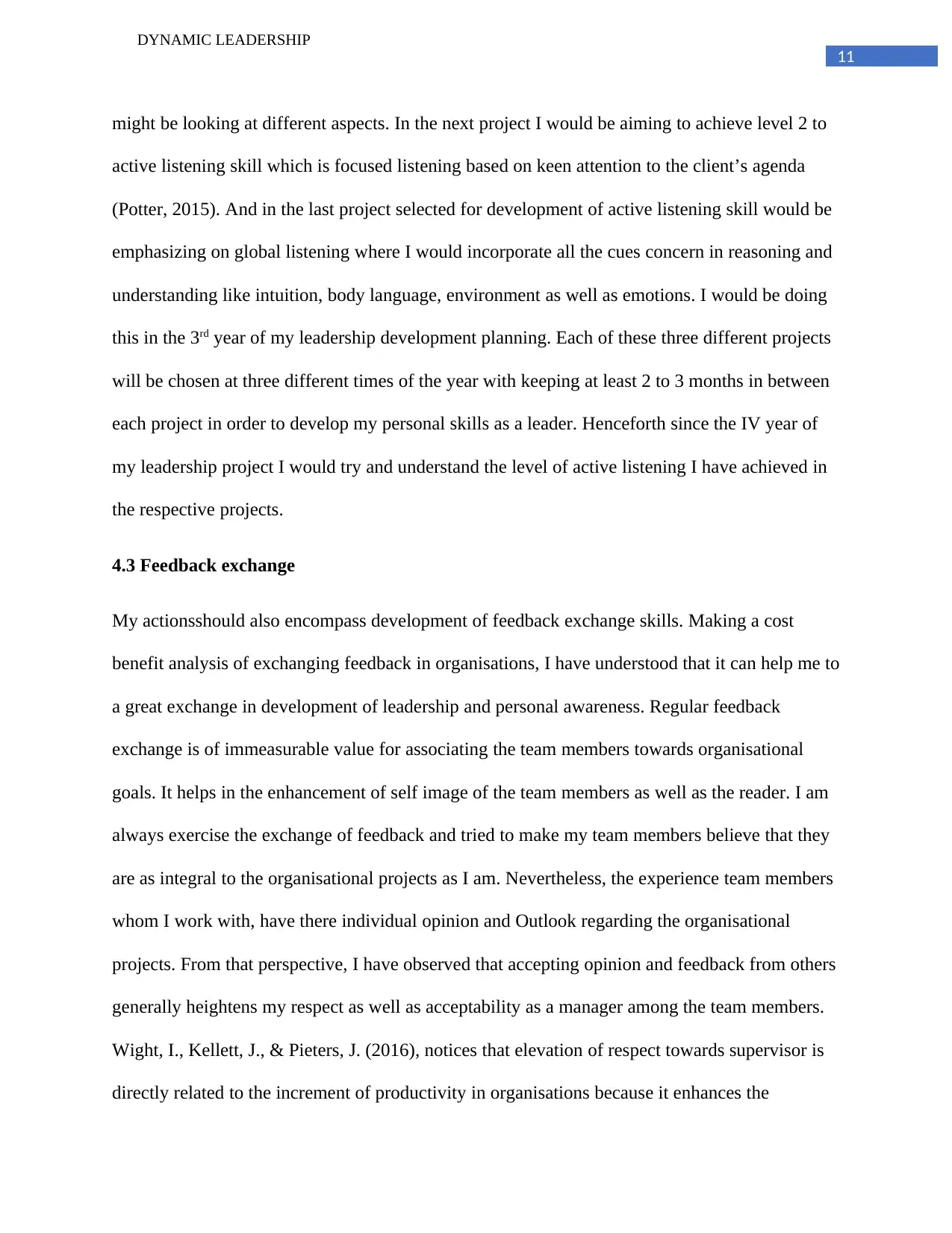
11
DYNAMIC LEADERSHIP
might be looking at different aspects. In the next project I would be aiming to achieve level 2 to
active listening skill which is focused listening based on keen attention to the client’s agenda
(Potter, 2015). And in the last project selected for development of active listening skill would be
emphasizing on global listening where I would incorporate all the cues concern in reasoning and
understanding like intuition, body language, environment as well as emotions. I would be doing
this in the 3rd year of my leadership development planning. Each of these three different projects
will be chosen at three different times of the year with keeping at least 2 to 3 months in between
each project in order to develop my personal skills as a leader. Henceforth since the IV year of
my leadership project I would try and understand the level of active listening I have achieved in
the respective projects.
4.3 Feedback exchange
My actionsshould also encompass development of feedback exchange skills. Making a cost
benefit analysis of exchanging feedback in organisations, I have understood that it can help me to
a great exchange in development of leadership and personal awareness. Regular feedback
exchange is of immeasurable value for associating the team members towards organisational
goals. It helps in the enhancement of self image of the team members as well as the reader. I am
always exercise the exchange of feedback and tried to make my team members believe that they
are as integral to the organisational projects as I am. Nevertheless, the experience team members
whom I work with, have there individual opinion and Outlook regarding the organisational
projects. From that perspective, I have observed that accepting opinion and feedback from others
generally heightens my respect as well as acceptability as a manager among the team members.
Wight, I., Kellett, J., & Pieters, J. (2016), notices that elevation of respect towards supervisor is
directly related to the increment of productivity in organisations because it enhances the
DYNAMIC LEADERSHIP
might be looking at different aspects. In the next project I would be aiming to achieve level 2 to
active listening skill which is focused listening based on keen attention to the client’s agenda
(Potter, 2015). And in the last project selected for development of active listening skill would be
emphasizing on global listening where I would incorporate all the cues concern in reasoning and
understanding like intuition, body language, environment as well as emotions. I would be doing
this in the 3rd year of my leadership development planning. Each of these three different projects
will be chosen at three different times of the year with keeping at least 2 to 3 months in between
each project in order to develop my personal skills as a leader. Henceforth since the IV year of
my leadership project I would try and understand the level of active listening I have achieved in
the respective projects.
4.3 Feedback exchange
My actionsshould also encompass development of feedback exchange skills. Making a cost
benefit analysis of exchanging feedback in organisations, I have understood that it can help me to
a great exchange in development of leadership and personal awareness. Regular feedback
exchange is of immeasurable value for associating the team members towards organisational
goals. It helps in the enhancement of self image of the team members as well as the reader. I am
always exercise the exchange of feedback and tried to make my team members believe that they
are as integral to the organisational projects as I am. Nevertheless, the experience team members
whom I work with, have there individual opinion and Outlook regarding the organisational
projects. From that perspective, I have observed that accepting opinion and feedback from others
generally heightens my respect as well as acceptability as a manager among the team members.
Wight, I., Kellett, J., & Pieters, J. (2016), notices that elevation of respect towards supervisor is
directly related to the increment of productivity in organisations because it enhances the
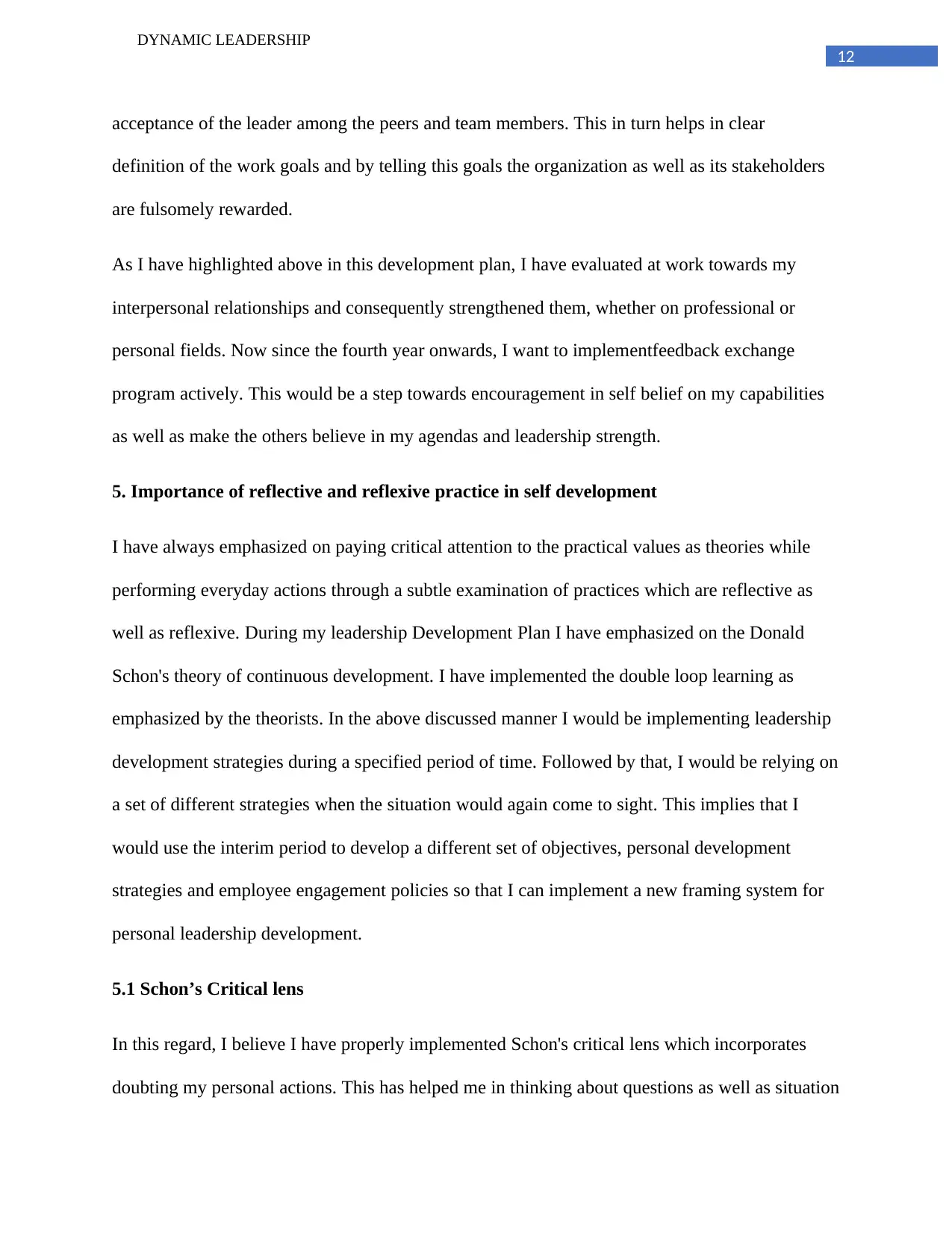
12
DYNAMIC LEADERSHIP
acceptance of the leader among the peers and team members. This in turn helps in clear
definition of the work goals and by telling this goals the organization as well as its stakeholders
are fulsomely rewarded.
As I have highlighted above in this development plan, I have evaluated at work towards my
interpersonal relationships and consequently strengthened them, whether on professional or
personal fields. Now since the fourth year onwards, I want to implementfeedback exchange
program actively. This would be a step towards encouragement in self belief on my capabilities
as well as make the others believe in my agendas and leadership strength.
5. Importance of reflective and reflexive practice in self development
I have always emphasized on paying critical attention to the practical values as theories while
performing everyday actions through a subtle examination of practices which are reflective as
well as reflexive. During my leadership Development Plan I have emphasized on the Donald
Schon's theory of continuous development. I have implemented the double loop learning as
emphasized by the theorists. In the above discussed manner I would be implementing leadership
development strategies during a specified period of time. Followed by that, I would be relying on
a set of different strategies when the situation would again come to sight. This implies that I
would use the interim period to develop a different set of objectives, personal development
strategies and employee engagement policies so that I can implement a new framing system for
personal leadership development.
5.1 Schon’s Critical lens
In this regard, I believe I have properly implemented Schon's critical lens which incorporates
doubting my personal actions. This has helped me in thinking about questions as well as situation
DYNAMIC LEADERSHIP
acceptance of the leader among the peers and team members. This in turn helps in clear
definition of the work goals and by telling this goals the organization as well as its stakeholders
are fulsomely rewarded.
As I have highlighted above in this development plan, I have evaluated at work towards my
interpersonal relationships and consequently strengthened them, whether on professional or
personal fields. Now since the fourth year onwards, I want to implementfeedback exchange
program actively. This would be a step towards encouragement in self belief on my capabilities
as well as make the others believe in my agendas and leadership strength.
5. Importance of reflective and reflexive practice in self development
I have always emphasized on paying critical attention to the practical values as theories while
performing everyday actions through a subtle examination of practices which are reflective as
well as reflexive. During my leadership Development Plan I have emphasized on the Donald
Schon's theory of continuous development. I have implemented the double loop learning as
emphasized by the theorists. In the above discussed manner I would be implementing leadership
development strategies during a specified period of time. Followed by that, I would be relying on
a set of different strategies when the situation would again come to sight. This implies that I
would use the interim period to develop a different set of objectives, personal development
strategies and employee engagement policies so that I can implement a new framing system for
personal leadership development.
5.1 Schon’s Critical lens
In this regard, I believe I have properly implemented Schon's critical lens which incorporates
doubting my personal actions. This has helped me in thinking about questions as well as situation
⊘ This is a preview!⊘
Do you want full access?
Subscribe today to unlock all pages.

Trusted by 1+ million students worldwide
1 out of 19
Related Documents
Your All-in-One AI-Powered Toolkit for Academic Success.
+13062052269
info@desklib.com
Available 24*7 on WhatsApp / Email
![[object Object]](/_next/static/media/star-bottom.7253800d.svg)
Unlock your academic potential
Copyright © 2020–2025 A2Z Services. All Rights Reserved. Developed and managed by ZUCOL.




